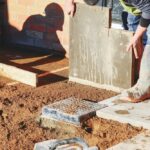Tips for Curing Concrete in Cold Weather
Most concrete contractors prefer to avoid putting down exterior concrete during the winter because, once the temperature dips below 40 degrees Fahrenheit, projects take on a whole new level of challenge. If done improperly, cold weather concrete in Racine, WI can come out vulnerable and weak.
In our neck of the woods, however, low temperatures are a fact of life. As a result, so are cold weather concrete jobs. Not to worry, with a little education, you can turn your cold weather concrete job into a total success.
Why is it a problem to cure concrete when it’s cold?
Without getting into the nitty-gritty of the chemistry behind cold weather concrete curing, suffice it to say that when your concrete is poured onto the ground, the water content inside is susceptible to freezing. If that’s allowed to happen, it can cause long-term complications that harm the structural integrity of the concrete itself.
That said, there are several strategies employed by contractors to ensure that nothing goes wrong when installing cold weather concrete in Racine, WI.
Keep it covered
The most critical step in keeping your concrete job from failing is to keep your concrete above a specific temperature after it has been spread and smoothed. Contractors use a variety of tools—everything from insulated blankets to thin membranes—to ensure that the concrete’s temperature stays within a window of 45 to 70 degrees Fahrenheit.
You’ll need to maintain different internal temperatures in your concrete, depending on how thick or thin it is.
Watch your corners
Anyone who puts down a covering to ensure their concrete remains warm will naturally want to secure the blanket against high winds or inclement weather like wind and snow. That said, when putting down your covering, it is vital to pay close attention to the insulation around your corners. More often than not, the core of your concrete will be able to maintain its temperature. The corners, however, will lose their heat quickly and could be vulnerable in the long term.
Use chemically-treated concrete
You don’t need to lay down your parents’ old-fashioned concrete. Advancements in the concrete industry have seen the invention of concrete saturated with accelerated-set chemicals. Insulation remains necessary for concrete in these cases, but chemicals can go a long way toward shortening the duration of time needed for your concrete to cure.
Get help from the pros
At Langenfeld Masonry & Concrete, we’re here to take the guesswork out of cold weather concrete in Racine, WI. Our family owned and operated business has proudly served the Racine, Kenosha and South Milwaukee area since 1912. A company doesn’t stay up and running for more than a century without some serious know-how and an unparalleled commitment to customer service.
Whether your needs are residential or commercial, we have the knowledge and experience you need to ensure that your cold weather concrete is installed the right way, every time.
When you need the best, you need Langenfeld Masonry & Concrete. We’re ready and waiting to serve you. Visit us online or give us a call to schedule an appointment.
More...
Categorised in: Concrete Contractor




